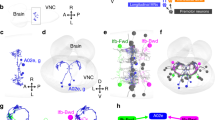Summary
In the pteropod mollusc Clione limacina, wing retraction takes precedence over spontaneous and continuous swimming, a phenomenon here defined as behavioral switching. The wing retraction system is organized as a simple reflex in which wing mechanoreceptors activate a pair of retraction interneurons which in turn excite at least two pairs of retraction motoneurons.
Activation of individual mechanoreceptors does not inhibit swimming or trigger wing retraction. A pair of retraction interneurons can fully suppress swimming when induced to fire at physiological frequencies, and may be both sufficient and necessary for swim inhibition.
Retraction interneurons monosynaptically inhibit both swim interneurons and swim motoneurons. Retraction motoneurons inhibit swim motoneurons through a polysynaptic pathway.
A model summarizing the neural circuitry underlying behavioral switching in Clione is presented. A comparison of this model with the behavioral choice model in Pleurobranchaea reveals that the overall neural mechanisms for behavioral choice and behavioral switching are similar as both involve dual function interneurons that not only activate their own motor pathway, but also inhibit the competing motor system. While inhibition is biased toward the afferent side of the competing circuit in behavioral choice, it is biased to the efferent side in behavioral switching.
Similar content being viewed by others
References
Arshavsky YI, Beloozerova IN, Orlovsky GN, Panchin YV, Pavlova GA (1985a) Control of locomotion in marine mollusc Clione limacina. I. Efferent activity during actual fictitious swimming. Exp Brain Res 58:255–262
Arshavsky YI, Beloozerova IN, Orlovsky GN, Panchin YV, Pavlova GA (1985b) Control of locomotion in marine mollusc Clione limacina. II. Rhythmic neurons of pedal ganglia. Exp Brain Res 58:263–272
Arshavsky YI, Beloozerova IN, Orlovsky GN, Panchin YV, Pavlova GA (1985c) Control of locomotion in marine mollusc Clione limacina. III. On the origin of locomotory rhythm. Exp Brain Res 58:273–284
Arshavsky YI, Beloozerova IN, Orlovsky GN, Panchin YV, Pavlova GA (1985d) Control of locomotion in marine mollusc Clione limacina. IV. Role of type 12 interneurons. Exp Brain Res 58:285–293
Audesirk GJ, Audesirk TE (1980a) Complex mechanoreceptors in Tritonia diomedea. I. Responses to mechanical and chemical stimuli. J Comp Physiol 141:101–109
Audesirk GJ, Audesirk TE (1980b) Complex mechanoreceptors in Tritonia diomedea. II. Neural correlates of a change in behavioral responses. J Comp Physiol 141:111–122
Bryant H (1977) Differential sensitivity of Aplysia axons to pharmacological and ionic manipulations. Soc Neurosci Abstr 3:173
Camhi JM (1977) Behavioral switching in cockroaches: Transformation of tactile reflexes during righting behavior. J Comp Physiol 113:283–301
Cobbs JS, Pinsker HM (1982) Role of bag cells in egg deposition of Aplysia brasilia. I. Comparison of normal and elicited behavior. J Comp Physiol 147:523–535
Cohen JL, Weiss KR, Kupfermann I (1978) Motor control of buccal muscles in Aplysia. J Neurophysiol 41:157–180
Davis WJ, Mpitsos GJ, Pinneo JM (1974a) The behavioral hierarchy of the mollusc Pleurobranchaea. I. The dominant position of the feeding behavior. J Comp Physiol 90:207–224
Davis WJ, Mpitsos GJ, Siegler J, Pinneo M (1974b) Neuronal substrates of behavioral hierarchies and associative learning in Pleurobranchaea. Am Zool 14:1037–1050
Everett RA, Ostfeld RS, Davis WJ (1982) The behavioral hierarchy of the garden snail Helix aspersa. Z Tierpsychol 59:109–126
Fredman SM, Jahan-Parwar B (1977) Identifiable cerebral motoneurons mediating an anterior tentacular withdrawal reflex in Aplysia. J Neurophysiol 40:608–615
Getting P (1981) Mechanisms of pattern generation underlying swimming in Tritonia. I. Neuronal network formed by monosynaptic connections. J Neurophysiol 46:65–79
Huang Z, Satterlie RA (1989) Organization and ultrastructure of the wing retraction musculature in the pteropod mollusc Clione limacina. Cell Tissue Res 257:405–414
Jahan-Parwar B (1980) Modification of sensory evoked behavioral and neural responses during different behavioral states in Aplysia. Neurosci Abstr 6:585
Kandel E (1976) Cellular basis of behavior. Freeman, San Francisco
Kovac MP, Davis WJ (1977) Behavioral choice: neurophysiological mechanisms in Pleurobranchaea. Science 198:632–634
Kovac MP, Davis WJ (1980) Neuronal mechanisms underlying behavioral choice in Pleurobranchaea. J Neurophysiol 43:469–487
Krasne FB, Lee SC (1988) Response-dedicated trigger neurons as control points for behavioral actions: selective inhibition of lateral giant command neurons during feeding in crayfish. J Neurosci 8:3703–3712
Kupfermann I, Weiss KR (1978) The command neuron concept. Behav Brain Sci 1:3–39
Lever AJ, Vlieger TA de, Kraal H (1977) A behavioral and electrophysiological study of the withdrawal reaction of the pond snail Lymnaea stagnalis with particular reference to tentacle contraction. Proc K Ned Akad Wet 80:105–113
Ram JL, Niorot G, Waddell S, Anderson MA (1988) Singleness of action in the interactions of feeding with other behaviors in Hermissenda crassicornis. Behav Neural Biol 49:97–111
Satterlie RA (1985) Reciprocal inhibition and postinhibitory rebound produce reverberation in a locomotor pattern generator. Science 229:402–404
Satterlie RA (1988) Reciprocal inhibition and rhythmicity: swimming in a pteropod mollusk. In: Jacklet JW (ed) Neuronal and cellular oscillators. Marcel Dekker, New York, pp 149–171
Satterlie RA, Spencer AN (1985) Swimming in the pteropod mollusc, Clione limacina. II. Physiology. J Exp Biol 116:205–222
Satterlie RA, LaBarbera M, Spencer AN (1985) Swimming in the pteropod mollusc, Clione limacina. I. Behavior and morphology. J Exp Biol 116:189–204
Tinbergen N (1950) The study of instinct. Oxford University Press, Oxford
Author information
Authors and Affiliations
Rights and permissions
About this article
Cite this article
Huang, Z., Satterlie, R.A. Neuronal mechanisms underlying behavioral switching in a pteropod mollusc. J Comp Physiol A 166, 875–887 (1990). https://doi.org/10.1007/BF00187335
Accepted:
Issue Date:
DOI: https://doi.org/10.1007/BF00187335




